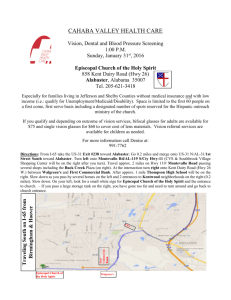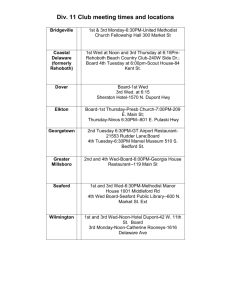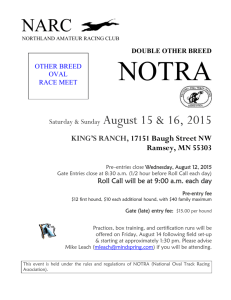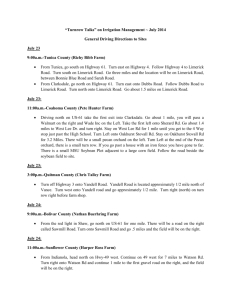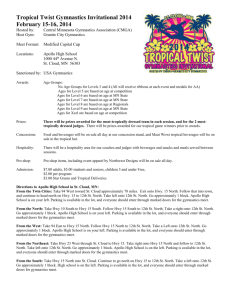Diary of the First Presidential Visit to the Palmetto State
advertisement
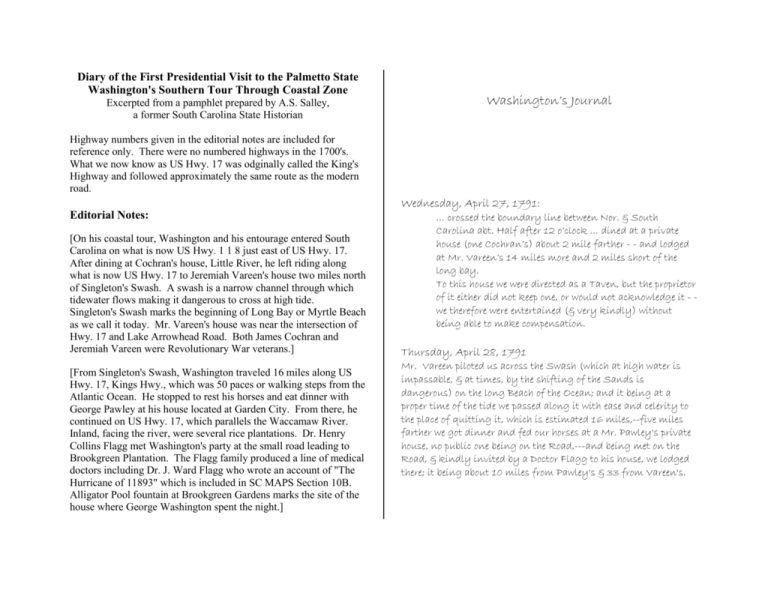
Diary of the First Presidential Visit to the Palmetto State Washington's Southern Tour Through Coastal Zone Excerpted from a pamphlet prepared by A.S. Salley, a former South Carolina State Historian Washington’s Journal Highway numbers given in the editorial notes are included for reference only. There were no numbered highways in the 1700's. What we now know as US Hwy. 17 was odginally called the King's Highway and followed approximately the same route as the modern road. Wednesday, April 27, 1791: Editorial Notes: [On his coastal tour, Washington and his entourage entered South Carolina on what is now US Hwy. 1 1 8 just east of US Hwy. 17. After dining at Cochran's house, Little River, he left riding along what is now US Hwy. 17 to Jeremiah Vareen's house two miles north of Singleton's Swash. A swash is a narrow channel through which tidewater flows making it dangerous to cross at high tide. Singleton's Swash marks the beginning of Long Bay or Myrtle Beach as we call it today. Mr. Vareen's house was near the intersection of Hwy. 17 and Lake Arrowhead Road. Both James Cochran and Jeremiah Vareen were Revolutionary War veterans.] [From Singleton's Swash, Washington traveled 16 miles along US Hwy. 17, Kings Hwy., which was 50 paces or walking steps from the Atlantic Ocean. He stopped to rest his horses and eat dinner with George Pawley at his house located at Garden City. From there, he continued on US Hwy. 17, which parallels the Waccamaw River. Inland, facing the river, were several rice plantations. Dr. Henry Collins Flagg met Washington's party at the small road leading to Brookgreen Plantation. The Flagg family produced a line of medical doctors including Dr. J. Ward Flagg who wrote an account of "The Hurricane of 11893" which is included in SC MAPS Section 10B. Alligator Pool fountain at Brookgreen Gardens marks the site of the house where George Washington spent the night.] … crossed the boundary line between Nor. & South Carolina abt. Half after 12 o’clock … dined at a private house (one Cochran’s) about 2 mile farther - - and lodged at Mr. Vareen’s 14 miles more and 2 miles short of the long bay. To this house we were directed as a Taven, but the proprietor of it either did not keep one, or would not acknowledge it - we therefore were entertained (& very kindly) without being able to make compensation. Thursday, April 28, 1791 Mr. Vareen piloted us across the Swash (which at high water is impassable, & at times, by the shifting of the Sands is dangerous) on the long Beach of the Ocean; and it being at a proper time of the tide we passed along it with ease and celerity to the place of quitting it, which is estimated 16 miles,--five miles farther we got dinner and fed our horses at a Mr. Pawley's private house, no public one being on the Road,---and being met on the Road, & kindly invited by a Doctor Flagg to his house, we lodged there; it being about 10 miles from Pawley's & 33 from Vareen's. [Also living in the Waccamaw Neck was William Alston, who owned Clifton Plantation, located just off of US Hwy. 17. Washington ate breakfast with Alston, who served as a captain in the South Carolina Militia during the Revolutionary War. The Charleston reception committee greeting Washington included MajorGeneral William Moultrie, Revolutionary War hero and former governor; Colonel William Washington, cousin of the president and also a Revolutionary War hero; and John Rutledge, Jr., son of the Revolutionary War governor and former Justice of the United States Supreme Court.] the neatest Rice planters in the State of So. Carolina and a proprietor of the most valuable ground for the culture of this article.-His house which is large, new, and elegantly furnished stands on a sand hill, high for the Country, with his Rice Fields below,, the contrast of which with the lands back of it, and the Sand & piney barrens through which we had passed is scarcely to be conceived. At Captn. Alston's we were met by General Moultree, CoL Washington & Mr. Rutledge (son of the present Chief Justice of So. Carolina) who had come out that far to escort me to town.-We dined and lodged at this Gentlemans and Boats being provided we the next momin ... Saturday, April 30, 1791 [George Washington was rowed across the Waccamaw River to Georgetown by seven captains of vessels, dressed in round hats trimmed with gold lace, blue coats, and white jackets riding in an elegantly painted boat. He stayed at the Stewart-Parker house, which is still standing today in the historic district of Georgetown. At Prince George's Lodge, he addressed the Masonic Order and attended a party given to him by more that 50 Georgetown ladies.] Friday, April 29, 1791 We left Doctr. Flagg's about 6 o'clock, and arrived at Captn. Wm. Alston's on the Waggamau [Waccamaw River] to Breakfast. Captn. Alston is a Gentleman of large fortune and esteemed one of Crossed the Waggamau [Waccamaw River] to Georgetown by descending the River three miles-at this place we were recd. under a Salute of Cannon, & by a Company of Infantry handsomely uniformed.-I dined with the Citizens in public; and in the afternoon, was introduced to upwards of 50 ladies who had assembled (at a Tea party) on the occasion. [Washington left Georgetown on US Hwy. 17 crossing the Sampit River. He continued on this road crossing the North Santee and South Santee rivers on the Santee Delta and arriving for breakfast at Hampton Plantation, now Hampton State Park, just west of US Hwy. 17. Greeting him were Mrs. (Daniel) Harriott Pinckney Horry and her mother Eliza Lucas Pinckney. Colonel Daniel Horry had been a rice planter, sportsman, and Revolutionary War cavalryman until his death in 1785. Eliza Lucas Pinckney is credited with becoming a successful lady planter and introducing indigo as a new cash crop to the Low Country. George Washington voluntarily served as a pallbearer at her funeral when she died in Philadelphia in 1793. See SC MAPS Section 9: Coastal Zone Overview, to find out more about Eliza Lucas Pinckney's contribution to the state. That night he lodged with Joseph Manigault at his plantation on Awendaw Creek just off of US Hwy. 17. Salt Hope Plantation is now part of the Cape Romain National Wildlife Refuge.] [Governor Pinckney's County Seat was a small estate in Christ Church Parish called Snee Farm just north of Mt. Pleasant on US Hwy. 17. This farm is currently under the jurisdiction of the National Park Service. Washington later wrote that he thought the road from Georgetown to Charleston was the most beautiful in the United States. Washington's entrance to Charleston was a gala event with the flotilla leaving Haddrel's Point at Mt. Pleasant. A group of dignitaries escorted Washington across the bay in an elegant twelveoared barge. Accompanying him was St. Philip's Church Choir singing and playing instruments from two other boats. East Bay Street was lined with spectators, while others watched from windows and balconies. The Charleston Artillery Battalion fired a 15 gun federal salute and the bells at St. Michael's Church rang. The clock tower of St. Philip's Church indicated the time as 2 p.m. It was Monday, May 2, 1791. The Exchange building where Washington was entertained is located at East Bay and Broad Streets. Today, it is a museum operated by the Daughters of the American Revolution and is called The Old Exchange and Provost Dungeon. Sunday, May 1, 1791 Left Georgetown about 6 o'clock and crossing the Santee Creek at the town, and the Santee River 12 miles from it, at Lynch's Island, we breakfasted and dined at Mrs. Horry's about 15 miles from Georgetown & lodged at the Plantation of Mr. Manigold about 19 miles farther. Monday, May 2,1791 Breakfasted at the Country Seat of Govr. Pinckney (Snee Farm) about 18 miles from our lodging place, & then came to the ferry at Haddrel's point [Mt. Pleasant], 6 miles further where / was met by the Recorder of the City, Genl. Pinckney & Edward Rutledge, Esqr. in a 12 oared barge rowed by 12 Amen . can Captains of Ships, most elegantly dressed.-There were a great number of other Boats with Gentlemen and ladies in them;-and two Boats with Music, all of whom attended me across, and on the passage were met by a number of others.-As we approached the town a salute with artillery commenced, and at the Wharf / was met by the Governor, and Lt. Governor ... two Senators of the State, Wardens of the City ... conducted to the Exchange where they passed by in procession. . . President George Washington was elegantly entertained in Charleston where he spent the week of May 2-9, 1791. While there, several balls were held in his honor. He took special note to mention the "elegantly dressed and, handsome ladies. " He dined with citizens at a public dinner and was entertained by the elite Society of the Cincinnati, visited Fort Johnson and Fort Moultrie by boat, ate breakfast with orphans, and attended services at both St. Philip's and St. Michael's Episcopal Churchs. On Monday May 9, he crossed over the Ashley River on Hampton's Bridge, US Hwy. 17, and headed to Savannah.] It may as well in this as in any other place, he observed, that the Country from Wilmington through which the Road passes, is, except in very smag spots, much the same as what has already been described,, that is to say, sand & pine barrens-with very few inhabitants-we were indeed informed that at some distance from the Road on both sides the land was of a better quality, & thicker settled, but this could only be on the Rivers & larger waters-for a perfect sameness seems to run through all the rest of the Countryon these-especially the swamps and low lands on the Rivers, the Soil is very rich; and productive when reclaimed, but to do this is both laborious and expensive.-The Rice planters have two modes of watering their fields-the first by the tide-the other by resurvoirs drawn from the adjacent lands.-The former is best because most certain. Monday, May 9, 1791 [Washington stayed at Sandy Hill Plantation just south of US Hwy. 17 with his cousin Col. William Washington, who had married an heiress of a rice plantation. Even though William had only lived in South Carolina a short time, he had become a very successful rice planter.] At six o'clock / recommenced my joumey for Savanna; attended by a Corps of the Cincinnati and most of the principal Gentlemen of the city as far as the bridge over Ashley River, where we breakfasted, and proceeded to CoL W Washington at Sandy-hffl with a select party of particular friends-distance from Charieston 28 miles. Tuesday, May 10, 1791 [Judge Thomas Bee's plantation was on the road to Jacksonboro now US Hwy. 17. From there, Washington left present day US Hwy. 17 and turned onto, what would become Hwy. 64 heading northwestward. About midway to Walterboro, he turned left on Hwy. 41 and went through Rifter then south to Duharra Plantation.] . . . breakfasting at Judge Bee's 12 miles from Sandy Hill, lodged at Mr. Obrain Smith's Duhaffa plantation 18 or 20 miles further on. [Washington spent the night at Duharra Plantation owned by O'Brien Smith. He went back to Hwy. 41 and turned south on US Hwy. 17 Alt. He passed through Yemassee and then Pocotaligo, where US Hwy. 17 and US Hwy. 17 Alt. merge and follow present day 1-95. Originally, Pocotaligo was a trading post for the Yemassee. It is located at the intersection of US Hwy. 17 and the Beaufort highway. From there, Washington followed present day 1-95 to Coosawhatchie, where he took Hwy. 462 to White Hall Plantation. George Washington stayed at two of Judge Thomas Hayward's homes, a town house located on Church Street Charleston and White Hall Plantation on Euhaw Creek in Jasper County. Thomas Hayward is one of the two signers of the Declaration of Independence from South Carolina.] Wednesday, May 11, 1791 [Leaving White Hall Plantation, Washington took Hwy. 278 to Grahamville turning on Hwy. 13 and then taking Hwy. 169 to Purryburg on the Savannah River. He left South Carolina between ten and eleven o'clock, and was escorted across the Savannah River in a handsome eight-oared presidential barge followed by a flotilla carrying his coach and baggage wagon. He landed at Mulberry Grove plantation and dined with Catherine Greene, widow of General Nathanael Greene, Revolutionary War general. From May 12-21, 1791, George Washington toured Georgia, visiting Savannah, Waynesboro, and Augusta, before returning to South Carolina on May 21, 1791.] Thursday, May 12, 1791 [A three gun salute was fired as George Washington reentered South Carolina from Augusta over Hampton's Bridge, spanning the Savannah River. He was escorted by a four member delegation: Colonel Wade Hampton, Colonel Thomas Taylor, Robert Lithgow from Columbia, and Archibold Jamison from Granby. Wade Hampton was a business man, Revolutionary War Colonel, planter, and owner of Hampton's Bridge and the Congaree River Ferry. His family had settled on the Tyger River in Spartanburg County when Saturday, May 21, 1791 After an early breakfast at Mr. (O'Brien] Smiths [Duharra Plantation] we rode 20 miles to a place called Pokitellieo where dinner was provided by the Parishoners of Prince William .... Afte@r dinner we proceeded 16 miles farther to Judge Hayward's where we lodged [White Hall Plantation] . . . there being no public houses on the Road and my distance to get to these private ones increased at least 10 or 12 miles between Charleston and Savanna By five o'clock we set out from Judge Hayward's, and the road to Putisburgh 22 miles to breakfast. At that place I was met by ... from the city of Savanna to conduct me thither. Left Augusta about 6 o'clock, and takg. leave of the Governor & principal Gentlemen of the place at the bridge over Savanna River, where they had assembled for the purpose, / proceeded in Company with CoL Hampton & Taylor, & Mr. Lithgow a committee from Columbia, (who had come on to meet & conduct me to that place) & a Mr. Jameson from the Village of Granby on my Rout. he was a child. After his parents were murdered by a Cherokee war party, he moved to the fork between the Congaree and Wateree rivers. Later, Hampton served as a major general in the United States Army during the War of 1812. Hampton's Bridge, 800 feet long and 16 feet wide, opened in 1790 but was later swept away by a flood in 1796. Colonel Thomas Taylor, planter and business man, often called the "Father of Columbia" sold his plantation to the state as the site for the new Capitol when it was moved from Charleston to Columbia. He served as a colonel in the militia during the Revolutionary War. Mr. Robert Lithgow was the newly-elected Richland County Judge; and Archibald Jamieson had the contract to build- a bridge over a creek south of Granby, thereby upgrading the Charleston-Orangeburg-Columbia road. Washington's party left North Augusta on US Hwy. 25 and dined at Pine House Tavern just west of Trenton. Like at all of his stops, a crowd of local citizens gathered to shake hands and speak with him. He knew that there would be opposition to the excise tax, which had just been passed by Congress. Prior to his arrival, the Edgefield County Grand Jury had drafted this statement, 'We are of the opinion that all Excise Laws . . . are repugnant to the Conditions & Liberties of a free people. . ' . Excise will bear very & unequally hard on the Inhabitants of the Southern States." About the same time, an Abbeville County Grand Jury had argued that the law would favor northern commercial distilleries and breweries. As Washington continued on his goodwill tour, he was quoted in the "Independent Gazetteer and Agricultural Repository," Philadelphia, PA, 11 June 1791, as saying, "The discontent which it was supposed the last Revenue Act would create, . . . subside as fast as the law is explained." He felt that the "Whiskey Tax" could be enforced and that his mission had been successful. From Trenton, Washington followed Hwy. 75 to Ridge Spring and Hwy. 23 to Batesburg. At a crossroads between Batesburg and Leesville near present-day Hwy. 41, Washington spoke to a group of people. From Leesville, he followed present day Hwy. 330 and Hwy. 261 to Gilbert, where he may have eaten breakfast. He then traveled Hwy. 60 to Hwy. 70 and took US Hwy. 1 on into West Columbia.] (Washington's diary is not clear where he lodged for the night or -ate breakfast. Four miles east of Lexington, where he reached what is now US Hwy. 1, stands a Sycamore tree marking the place where many historians believe Washington talked with local residents while resting his foundering horse. When US Hwy. 1 was widened in 1972, a roadside park was created and a cutting from a descendent of the original tree was planted marking the site. Washington left US Hwy. 1 at Leaphart Road and passed through the town of Granby. At sunset, Washington crossed the Congaree River at Fridig's Landing located south of Granby. Wade Hampton and his brothers had acquired the franchise for the ferry crossing and named it Hampton's Ferry. They had equipped it with a rope and three flatbottomed boats enabling Washington and his entourage to have a safe and speedy trip across the river to Columbia. Records indicate that crowds lined the Congaree River on both sides anxiously awaiting the President's arrival. A procession formed as President George Washington mounted his white charger followed by his cream-colored coach drawn by four bay horses. The coachman and footmen were all formally dressed in blanket coats, white and orange live6es, jockey caps, buckskins, and boots. The baggage wagon followed this procession to the State House. From there Washington was taken to a house prepared for his arrival.] [Washington dressed in black-velvet formal wear to greet the guests. Sixteen after-dinner toasts were made identifying hopes for the future and concerns of the times. Topics of some of these toasts were: "A speedy establishment of a central federal city;" "The federal legislature--may their virtues and abilities be as much admired abroad, as they are respected at home;" "Sufficient means and speedy measures for opening the inland navigation of America;" Sunday, May 22,1791 Rode about 21 miles to breakfast, and passing through the village to Granby just below the falls in the Congaree (which was passed in a flat bottomed boat at a Rope Ferry,) I lodged at Columbia, the newly adopted Seat of the Government of South Carolina about 3 miles from it, on the No. side of the river, and 27 miles from my breakfasting stage. The whole Road from Augusta to Columbia is a pine barren of the worst sort, being hilly as well as poor. This circumstance added to the distance, length of the stages, want of water, and heat of the day, foundered one of my horses very badly. Beyond Granby 4 miles I was met by sevl. Gentlemen of that place & Wynnsborough [Winnsboro]; and on the banks of the River on the No. side by a number of others, who escorted me to Columbia. Monday, May 23, 1791 Dined at a public dinner in the State house with a number of Gentlemen & ladies of the Town of Columbia, & Country round about to the amt. of more than 150, of which 50 or 60 were of the latter. [The original State House was a wooden structure located with the west front facing Assembly Street and the east front facing Richardson Street (Main Street). It was burned during the Civil War. Major John R. Niernsee designed the blue granite State House which now stands on this site.] Tuesday, May 24, 1791 The condition of my foundered horse obliged me to remain at this place, contrary to my intention, this day also. Columbia is laid out upon a large scale; but in my opinion, had better been placed on the River below the falls.-It is now an uncleared wood, with very few houses in it, and those all wooden ones-The State House (which is also of wood) is a large and commodious building, but unfinished-The Town is on dry, but cannot be called high ground, and though surrounded by Piney & Sandy land is, itself, good-The State House is near two miles from the River at the confluence of the Broad & Saluda. From Granby the River is navigable for Craft which will, when the River is a little swelled, carry 3000 bushels of Grain--when at its usual heighth less, and always some.-The River from hence to the Wateree below which it takes the name of the Santee is very crooked, it being, according to the computed distance near 400 miles-Columbia from Charleston is 130 miles. Wednesday, May 25, 1791 (Washington left Columbia on the Old Camden Road, US Hwy. 12, which went through Forest Acres and Fort Jackson. It now feeds into 1-20. He entered Camden on current US Hwy. 521. A dinner was held in his honor and he toasted the memory of General Nathaniel Greene and Baron de Kalb who were local heroes of the Revolutionary War.] Set out at 4 o'clock for Camden-(the foundered horse being led slowly on)breakfasted at an indifferent house 22 miles from the town, (the first we came to) and reached Camden about two o'clock, 14 miles further, when an address was recd. & answered.-Dined (late with a number of Gentlemen & Ladies at a public dinner.-The Road from Columbia to Camden, excepting a mile or two at each place, goes over the most miserable pine barren I ever saw, being quite a white sand & very hilly.-On the Wateree within a mile & half of which the town stands and lands are very good, -they Culture corn, Tobacco & Indigo.- Vessels carrying 50 or 60 Hhds. of Tobo. come up to the Ferry at this place at which there is a Tobacco Mare-house. [Washington toured Revolutionary War battlefields evaluating the tactical performance of Generals Horatio Gates, Nathaniel Greene, Lord Cornwallis, and Lord Francis Rawdon. Leaving Camden, he followed US Hwy. 521 to Hwy. 58. Between Kershaw and Heath Springs in Lancaster County and just off of Hwy. 58 is the Hanging Rock Battlefield. It was the site of a fortified British post where General Thomas Sumter destroyed a regiment. Washington stayed with James and Margaret Ingram on their 2000 acre plantation near the Hanging Rock Battlefield. No doubt Washington toured this site. Just past Heath Springs, Washington took present day Hwy. 36, not shown on the state base map, to Hwy. 9, where he turned left going to Lancaster, From there, he followed US Hwy. 521 to Charlotte, North Carolina.] Thursday, May 26, 1791 After viewing the British works about Camden / set out for Charlotte-on my way-two miles from Town-I examined the ground on wch. GenL Green & Lord Rawdon had their action.-The ground had but just been taken by the former was well chosen-but he not well established in it before he was attacked,- which by capturing a Videt was, in some measure by surprise-Six miles further on / came to the ground where GenL Gates & Lord Cronwallis had their Engagement wch. terminated so unfavourably for the former. Camden is a small place with appearances of some new buildings.It was much injured by the British Whilst in their possession. After halting at one Sutton's 14 m from Camden / lodged at James lngram’s 12 miles farther. Entry for Friday, May 27, 1791 [Washington listened to the Catawba Chiefs' grievances, however, he did not act on them. It is thought that Washington knew the matter had already been placed in the hands of the state of South Carolina by Congress. On Saturday, May 27, 1791, Washington said good-bye to Major Crawford and left South Carolina on US Hwy. 521. As his cavalcade crossed the boundary line, Washington was again riding his white charger. A party of militiamen from Salisbury was there to greet him. From there he went to Charlotte, where hundreds had camped in wagons and tents to catch a glimpse of the first President of the United States of America, General George Washington. Left lngrams about 4 o'clock, and breakfasting at one Barr's 18 miles distant lodged at Majr. Crawford's 8 miles farther-About 2 miles this place I came to the comer where the No. Carolina line comes to the Rd.--from whence the Road is the boundary for 12 miles more.-At Majr. Crawford's / was met by some of the chiefs of the Catawba nation who seemed to be under apprehension that some attempts were in the making, or would be made to deprive them of part of the 40,000 Acres wch. was secured to them by Treaty and wch. is bounded by this Road.



